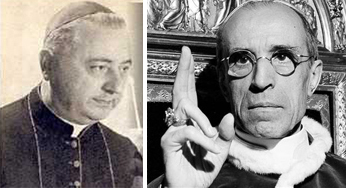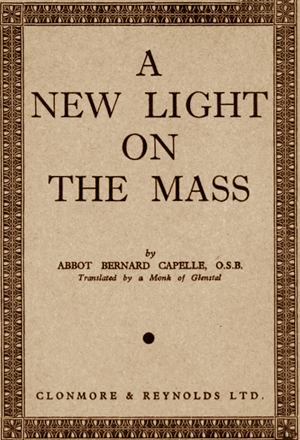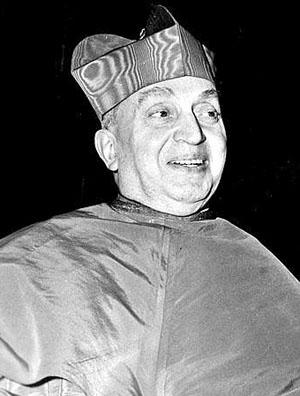Traditionalist Issues
 |
 |
 |
 |
 |
 |
 |
Dialogue Mass - LIV
Destroyers of the Mass of the Pre-Sanctified
Blessed by Pius XII
The fate of the Mass of the Pre-Sanctified was already sealed when Pius XII appointed his Commission for the General Reform of the Liturgy in 1948 and left it in the hands of the master of the dark arts himself, Fr. Annibale Bugnini. It was as counter-productive as inviting a group of deserters or draft dodgers to rewrite the rules of discipline and loyalty in the Armed Forces. No other outcome could have been expected from a Commission that gave precedence over Tradition to a set of reforms which were merely an expression of ideological views prevalent in the Liturgical Movement.
 In 1950, with Pius XII’s permission, Bugnini chose three “experts,” Fr. Josef Jungmann S.J., Dom Bernard Capelle O.S.B. and Mgr. Mario Righetti to guide the work of the Commission. As household names in the Liturgical Movement, they would later become members of the various Commissions that devised and implemented the Novus Ordo. (1)
In 1950, with Pius XII’s permission, Bugnini chose three “experts,” Fr. Josef Jungmann S.J., Dom Bernard Capelle O.S.B. and Mgr. Mario Righetti to guide the work of the Commission. As household names in the Liturgical Movement, they would later become members of the various Commissions that devised and implemented the Novus Ordo. (1)
Thinking with Bugnini
The idea of co-opting the support of those whom Bugnini considered a “safe pair of hands,” while excluding anyone (e.g. Mgr. Gromier) who respected the integrity of the Church’s lex orandi, can be considered a blatant abuse of ecclesiastical power. This in itself shows that the reforms were driven by an oligarchy of men who had made themselves the centre and judge of the Church’s Tradition and who had no scruples about depriving the faithful of their spiritual heritage. It also disproves the claim that applauding these reforms is equivalent to “thinking with the Church.”
In fact, the precise opposite is true: the Church has always in principle rejected the idea of a general reform of the liturgy conceived out of “pastoral expediency” based on the subjective perceptions of contemporary man.
 Here we are concerned with one of Bugnini’s protégés, Dom Bernard Capelle, Abbot of Mont-Cesar (Beauduin’s monastery) and Professor at the University of Louvain, for as one of Bugnini’s inner circle, Capelle was in a position of unrivalled influence at the very heart of the official Liturgical Movement. We will see how, through his reputation as a liturgical scholar, whatever he said about the Mass of the Pre-Sanctified would be accepted without question by the reformers and used as a lever to topple the ancient edifice.
Here we are concerned with one of Bugnini’s protégés, Dom Bernard Capelle, Abbot of Mont-Cesar (Beauduin’s monastery) and Professor at the University of Louvain, for as one of Bugnini’s inner circle, Capelle was in a position of unrivalled influence at the very heart of the official Liturgical Movement. We will see how, through his reputation as a liturgical scholar, whatever he said about the Mass of the Pre-Sanctified would be accepted without question by the reformers and used as a lever to topple the ancient edifice.
Where better to raise the profile of this particular reform than at the International Congress on the Liturgy held at Lugano in 1953? It was there that Dom Capelle gave a talk in which he pushed for the abolition of the Mass of the Pre-Sanctified.
Present at the Congress were two Cardinals (Ottaviani of the Holy Office and Frings of Cologne), some 15 Bishops, several members of the Congregation of Rites, many priests who were key activists for liturgical change and the ubiquitous Fr. Bugnini himself. (2)
No one else at the Congress, apart from the “in-crowd” around Bugnini, is likely to have known that Capelle was speaking on behalf of the Commission – he and the other consultors were sworn to secrecy in that connection. (3)
Capelle’s objections
He began by denigrating the traditional liturgy, accusing it of having become “weakened” and “denatured” over the centuries and said it needed to be restored to its original purity before being adapted to the mentality of modern man. (4)
Then, he brought up Fr. Antonelli’s arcane and irrelevant theory of consecration-by-contact. But, his main objection to the Pre-Sanctified rite was that it had taken certain prayers, gestures and ceremonies from the Mass: These included some Offertory prayers, the Elevation of the Host and the use of incense with its accompanying prayers as in a solemn liturgy. His words take on heightened significance when we consider that these features of the Mass were specifically singled out by Bugnini for removal from the liturgy. (5)
Capelle spoke as if with a sense of acute embarrassment, even shame, about these traditions of Catholic worship. He described them as “intolerable,” alleging that they gave “a false impression” that the Pre-Sanctified rite was a real Mass. (6) This conveys the subliminal message that it should be abolished. No wonder that the rite has ever since been regarded with suspicion and even disdain.
In its place, Capelle recommended a service of Communion for all, which, as we have seen, was Fr. Ferdinando Antonelli’s original idea.
Rome fiddles while Tradition burns
At this point, alarm bells should have been ringing throughout the Vatican. For such a proposal, when made into liturgical law two years later, would make it illicit to perform this distinctly Catholic rite that expressed the essential link between the Last Supper and Calvary. And furthermore, as history has shown, it would not be long before traditional Catholics would find themselves outlawed as well.
But, Rome had no intention of sending in the cavalry to rescue the Mass of the Pre-Sanctified from the jaws of defeat. As Fr. Antonelli recorded, not only was there a consensus among the progressivist liturgists for its abolition, but more importantly, the verdict of both the Papal Commission and the Congregation of Rites was overwhelmingly negative. (7)
 In addition, Card. Micara, President of the Commission and Pro-Prefect of the Congregation of Rites, was absent from the Congress, but sent a message of support, urging a reform of the Good Friday Liturgy. (8) Fr. Löw, Vice-Relator of the Congregation and a member of the Commission, was also absent, but had previously expressed disapproval of those elements of the Pre-sanctified rite that were taken from the Mass. (9)
In addition, Card. Micara, President of the Commission and Pro-Prefect of the Congregation of Rites, was absent from the Congress, but sent a message of support, urging a reform of the Good Friday Liturgy. (8) Fr. Löw, Vice-Relator of the Congregation and a member of the Commission, was also absent, but had previously expressed disapproval of those elements of the Pre-sanctified rite that were taken from the Mass. (9)
But “the unkindest cut of all” came from Pius XII himself, who did not intervene to save the “Mass of the Pre Sanctified” and allowed it to be excised from the Roman Rite. In fact, he had sent a personally signed message to the Congress, dated 9 September 1953, giving his heartfelt encouragement to the deliberations and bestowing his blessing on “each and every participant.” (10)
How many Catholics today, including traditionalists, know what the “Mass of the Pre-Sanctified” was? How could they, considering that it was abolished long before most of them were born? Some confuse its identity with the Good Friday Communion of the 1962 Missal. In other words, they do not know that there is anything to know about it – surely a very successful damnatio memoriae. Q.E.D.
Continued


Pius XII’s blessing for Bugnini’s reform
Thinking with Bugnini
The idea of co-opting the support of those whom Bugnini considered a “safe pair of hands,” while excluding anyone (e.g. Mgr. Gromier) who respected the integrity of the Church’s lex orandi, can be considered a blatant abuse of ecclesiastical power. This in itself shows that the reforms were driven by an oligarchy of men who had made themselves the centre and judge of the Church’s Tradition and who had no scruples about depriving the faithful of their spiritual heritage. It also disproves the claim that applauding these reforms is equivalent to “thinking with the Church.”
In fact, the precise opposite is true: the Church has always in principle rejected the idea of a general reform of the liturgy conceived out of “pastoral expediency” based on the subjective perceptions of contemporary man.

Capelle was a major player in shedding ‘new light’ on the Mass in the Liturgical Reform
Where better to raise the profile of this particular reform than at the International Congress on the Liturgy held at Lugano in 1953? It was there that Dom Capelle gave a talk in which he pushed for the abolition of the Mass of the Pre-Sanctified.
Present at the Congress were two Cardinals (Ottaviani of the Holy Office and Frings of Cologne), some 15 Bishops, several members of the Congregation of Rites, many priests who were key activists for liturgical change and the ubiquitous Fr. Bugnini himself. (2)
No one else at the Congress, apart from the “in-crowd” around Bugnini, is likely to have known that Capelle was speaking on behalf of the Commission – he and the other consultors were sworn to secrecy in that connection. (3)
Capelle’s objections
He began by denigrating the traditional liturgy, accusing it of having become “weakened” and “denatured” over the centuries and said it needed to be restored to its original purity before being adapted to the mentality of modern man. (4)
Then, he brought up Fr. Antonelli’s arcane and irrelevant theory of consecration-by-contact. But, his main objection to the Pre-Sanctified rite was that it had taken certain prayers, gestures and ceremonies from the Mass: These included some Offertory prayers, the Elevation of the Host and the use of incense with its accompanying prayers as in a solemn liturgy. His words take on heightened significance when we consider that these features of the Mass were specifically singled out by Bugnini for removal from the liturgy. (5)
Capelle spoke as if with a sense of acute embarrassment, even shame, about these traditions of Catholic worship. He described them as “intolerable,” alleging that they gave “a false impression” that the Pre-Sanctified rite was a real Mass. (6) This conveys the subliminal message that it should be abolished. No wonder that the rite has ever since been regarded with suspicion and even disdain.
In its place, Capelle recommended a service of Communion for all, which, as we have seen, was Fr. Ferdinando Antonelli’s original idea.
Rome fiddles while Tradition burns
At this point, alarm bells should have been ringing throughout the Vatican. For such a proposal, when made into liturgical law two years later, would make it illicit to perform this distinctly Catholic rite that expressed the essential link between the Last Supper and Calvary. And furthermore, as history has shown, it would not be long before traditional Catholics would find themselves outlawed as well.
But, Rome had no intention of sending in the cavalry to rescue the Mass of the Pre-Sanctified from the jaws of defeat. As Fr. Antonelli recorded, not only was there a consensus among the progressivist liturgists for its abolition, but more importantly, the verdict of both the Papal Commission and the Congregation of Rites was overwhelmingly negative. (7)

Card. Micara urged reform of
the Good Friday liturgy
But “the unkindest cut of all” came from Pius XII himself, who did not intervene to save the “Mass of the Pre Sanctified” and allowed it to be excised from the Roman Rite. In fact, he had sent a personally signed message to the Congress, dated 9 September 1953, giving his heartfelt encouragement to the deliberations and bestowing his blessing on “each and every participant.” (10)
How many Catholics today, including traditionalists, know what the “Mass of the Pre-Sanctified” was? How could they, considering that it was abolished long before most of them were born? Some confuse its identity with the Good Friday Communion of the 1962 Missal. In other words, they do not know that there is anything to know about it – surely a very successful damnatio memoriae. Q.E.D.
Continued
- Jungmann, Capelle and Righetti were members of the 1960 Central Preparatory Commission for the Liturgy. Capelle died in 1961. In 1964, Jungmann and Righetti were appointed as Consultors to Group 10 of the Consilium, which received the task of reforming the Order of Mass. All worked under Bugnini’s supervision.
- A list of attendees is given in La Maison-Dieu, 37, January 1954, pp. 8-9.
- The three consultors were required not to speak of their work to anyone else and, on completion of their observations, to return the “Memo” to the Commission. (See La Memoria sulla Riforma Liturgica, Supplement II, 1950)
- B. Capelle, ‘Le Vendredi Saint,’ La Maison-Dieu, n. 37, January 1954, p. 93.
- Bugnini mentioned in The Reform of the Liturgy 1948-1975 that the Consilium eliminated the Offertory prayers and attempted to do the same with the Oratre Fratres and the use of incense.
- B. Capelle, ‘Le Vendredi Saint,’ La Maison-Dieu, p.116.
- Antonelli stated, “Everyone [on the Commission] applauded the suppression of the so-called Mass of the Pres-Sanctified” and that “all the liturgists” agreed that it should be “eliminated.” (‘The Liturgical Reform of Holy Week, its Importance, Achievements and Perspectives,’ La Maison-Dieu, n. 47-8, 1956, pp. 229, 235)
- Cf. La Maison-Dieu, n. 37, January 1954, p. 10.
- He had made this statement in a speech given in Linz, Austria, shortly before the Congress. See La Maison-Dieu, n. 37, January, p. 126.
- La Maison-Dieu, n. 37, p. 3. And there was a letter from Mgr. Montini urging active participation for the faithful. Ibid., p. 10.

Posted July 3, 2017
______________________
______________________
 Volume I |
 Volume II |
 Volume III |
 Volume IV |
 Volume V |
 Volume VI |
 Volume VII |
 Volume VIII |
 Volume IX |
 Volume X |
 Volume XI |
 Special Edition |


